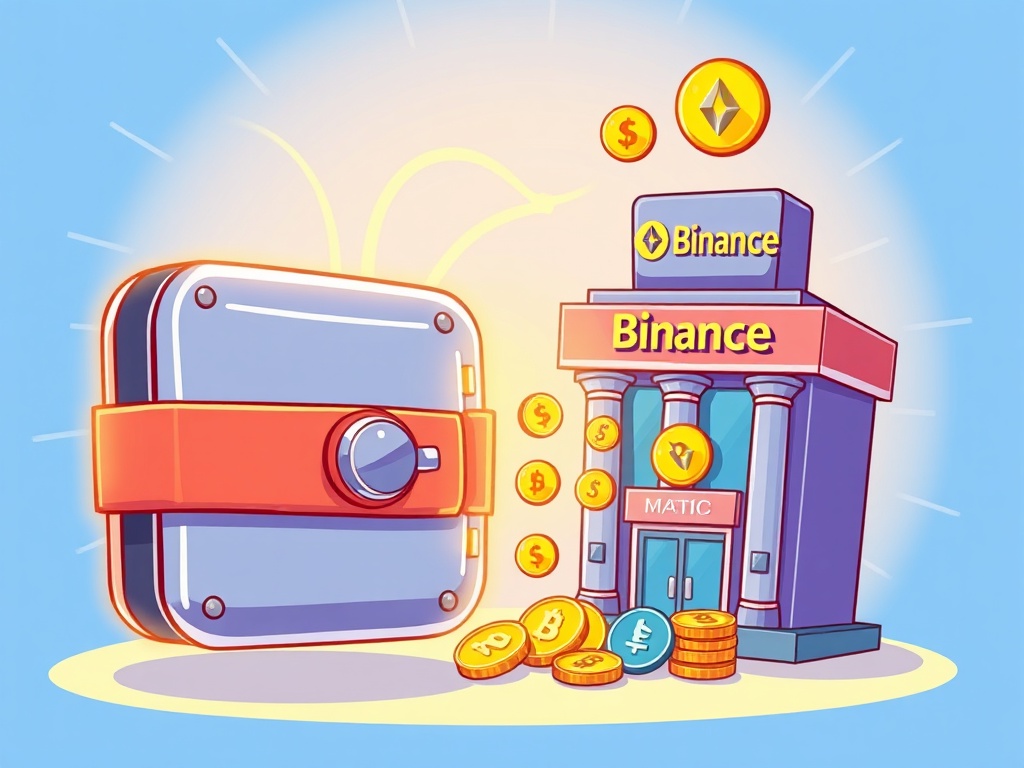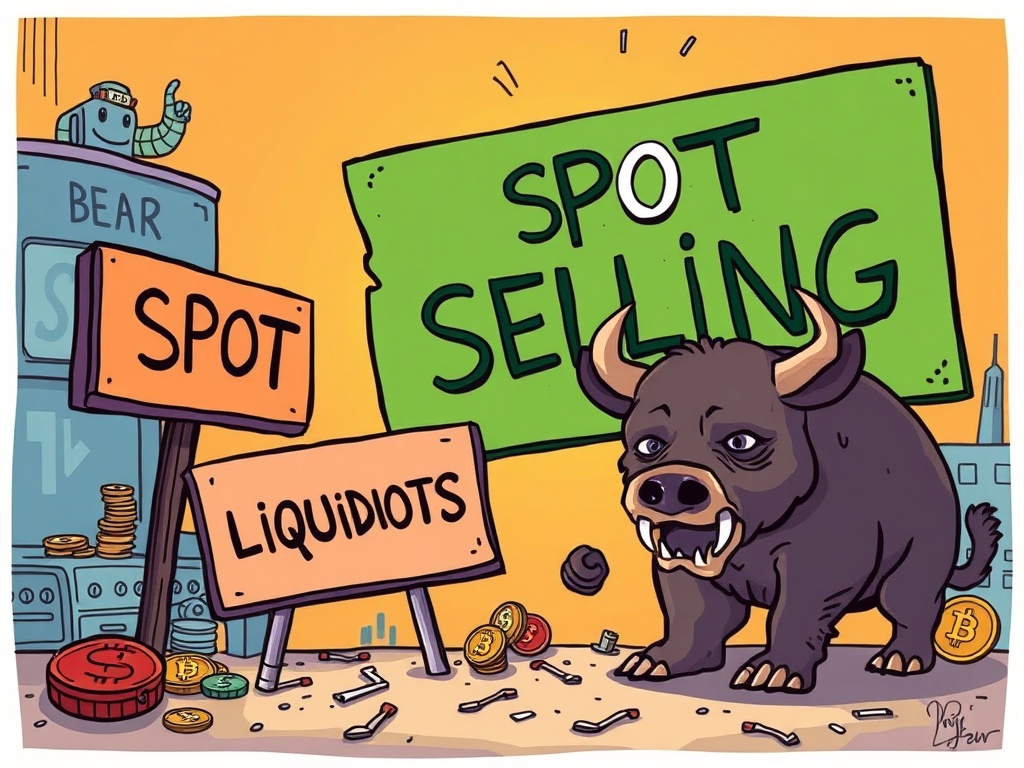BitcoinWorld

Strategic Binance Withdrawal: A New Wallet’s $4.2M Crypto Move Unveiled
In the ever-evolving world of cryptocurrency, significant movements of digital assets often capture the attention of investors and analysts alike. Recently, the crypto community buzzed with news of a substantial Binance withdrawal, where a newly created wallet moved a staggering $4.2 million in various cryptocurrencies from the popular exchange. This isn’t just a simple transaction; it’s a strategic maneuver that provides valuable insights into market sentiment and the behavior of large holders. Understanding these on-chain movements is crucial for anyone looking to navigate the complexities of the digital asset landscape.
Unpacking the Recent Strategic Binance Withdrawal
The specific details of this notable Binance withdrawal were brought to light by Onchain Lens on X, a reputable source for on-chain analytics. The newly established wallet orchestrated a multi-asset transfer, meticulously moving significant portions of several prominent cryptocurrencies. Let’s break down the components of this substantial transfer:
- 80,126 LINK: Valued at approximately $1.46 million, Chainlink’s native token, LINK, represents a key player in the decentralized oracle network space. Its inclusion suggests a belief in the long-term utility and adoption of oracle services.
- 110.34 Billion SHIB: Worth roughly $1.45 million, this massive amount of Shiba Inu (SHIB) highlights continued interest in meme coins, even among significant holders. It speaks to the speculative, yet often lucrative, nature of this segment of the market.
- 3.44 Million MATIC: Totaling about $762,000, Polygon’s MATIC token indicates an investment in scaling solutions for the Ethereum blockchain. This signals an understanding of the ongoing need for efficient and cost-effective transaction processing in the decentralized finance (DeFi) ecosystem.
- 142.62 ETH: Valued at approximately $552,000, Ethereum’s native cryptocurrency, ETH, remains a cornerstone of the crypto world. Its inclusion underscores confidence in the foundational blockchain that powers countless decentralized applications and innovations.
These transactions, particularly when originating from a newly created wallet and moving away from an exchange, are widely interpreted as moves towards self-custody or long-term holding. This means the assets are likely being transferred to a personal wallet, often a hardware wallet (cold storage), where the owner has direct control over their private keys, rather than leaving them on an exchange.
Why Do Large Crypto Withdrawals Matter? Decoding Wallet Behavior
When a substantial amount of cryptocurrency is moved from an exchange like Binance to a private wallet, it’s not just a technicality; it’s a signal. These large-scale Binance withdrawal events can offer several insights into the intentions of the holder and, by extension, potentially influence market sentiment:
1. The Shift to Self-Custody: One of the primary reasons for such a move is to enhance security. Keeping assets on an exchange exposes them to risks like hacks, regulatory seizures, or exchange insolvency. Moving them to a personal, non-custodial wallet gives the owner complete control and significantly reduces these risks. This often indicates a long-term conviction in the assets’ value, as the holder is willing to take on the responsibility of managing their own private keys.
2. Accumulation Phase: Large withdrawals can signal that a ‘whale’ (a large holder) is accumulating assets, moving them off the market to hold for an extended period. This reduces the immediate selling pressure on exchanges and can be seen as a bullish indicator, suggesting that the holder believes the price will appreciate in the future.
3. Reduced Exchange Liquidity: While not immediately impactful for smaller withdrawals, a series of large withdrawals can slightly reduce the liquidity available on exchanges. This means there might be fewer assets readily available for trading, which could, in extreme cases, contribute to price volatility if demand surges.
4. Preparation for DeFi or Other Protocols: Sometimes, assets are withdrawn from exchanges not just for holding, but to be utilized in decentralized finance (DeFi) protocols, staking, or other on-chain activities that require direct wallet connection. This suggests active participation in the broader crypto ecosystem.
Understanding the Assets: What Makes LINK, SHIB, MATIC, and ETH So Appealing?
The choice of assets in this particular Binance withdrawal is telling. It reflects a diversified strategy that taps into different facets of the crypto market:
- Chainlink (LINK): As a decentralized oracle network, Chainlink provides real-world data to smart contracts, enabling them to execute based on external information. Its importance grows with the expansion of DeFi and Web3, making it a fundamental piece of the blockchain infrastructure. Investors often see LINK as a long-term play on the maturation of decentralized applications.
- Shiba Inu (SHIB): Starting as a meme coin, SHIB has evolved to include its own ecosystem, including a decentralized exchange (ShibaSwap) and efforts towards a Layer-2 solution (Shibarium). Its appeal often lies in its strong community, viral potential, and the possibility of rapid price appreciation, albeit with higher volatility.
- Polygon (MATIC): Polygon is a leading Layer-2 scaling solution for Ethereum, aiming to address its scalability and high transaction fee issues. By offering faster and cheaper transactions, Polygon enhances the usability of Ethereum-based applications. MATIC’s inclusion suggests a belief in the continued growth of the Ethereum ecosystem and the necessity of scaling solutions.
- Ethereum (ETH): The second-largest cryptocurrency by market capitalization, Ethereum is the backbone of the decentralized internet. Its transition to Proof-of-Stake (the Merge) and ongoing upgrades aim to make it more scalable, secure, and sustainable. ETH is often considered a core holding for crypto investors due to its foundational role in DeFi, NFTs, and numerous other decentralized applications.
The combination of these assets suggests a balanced approach, blending established giants with promising scaling solutions and even high-potential meme coins, indicating a sophisticated understanding of the market’s diverse opportunities.
The Crucial Role of On-Chain Analytics in Tracking a Binance Withdrawal
In the transparent world of blockchain, every transaction leaves a trace. On-chain analytics platforms, like Onchain Lens, are indispensable tools for monitoring these movements. They provide the public with the ability to track large transfers, identify wallet addresses, and analyze transaction patterns.
How On-Chain Analytics Work:
- Data Aggregation: These platforms constantly scan blockchain networks, collecting data on every transaction, including sender/receiver addresses, amounts, timestamps, and fees.
- Wallet Profiling: They often categorize wallets (e.g., exchange wallets, whale wallets, miner wallets) to provide context to transactions.
- Pattern Recognition: Advanced algorithms identify unusual patterns, large transfers, or significant accumulations/distributions that might signal market shifts.
- Insights Generation: The raw data is then transformed into digestible insights, charts, and alerts that help investors understand market dynamics beyond just price charts.
For investors, monitoring these tools means gaining an edge. A large Binance withdrawal, when identified by an on-chain analyst, can prompt further investigation, helping one understand potential shifts in supply dynamics or long-term investor sentiment.
Is This a Bullish or Bearish Sign for the Crypto Market?
The interpretation of a large Binance withdrawal can vary, but generally, moving assets off an exchange is seen as a positive, or at least neutral, sign:
- Generally Bullish: When assets are withdrawn from exchanges, it typically means they are being moved to cold storage for long-term holding. This reduces the immediate selling pressure on the market, as these assets are no longer readily available for quick trades. It indicates strong conviction from the holder, suggesting they anticipate future price appreciation.
- Reduced Selling Pressure: Fewer coins on exchanges mean less potential supply available for immediate sale. If demand remains constant or increases, this supply crunch can lead to upward price pressure.
- Increased Decentralization: The move towards self-custody aligns with the core ethos of cryptocurrency – decentralization. It empowers individuals with full control over their assets, reducing reliance on centralized entities.
While a withdrawal doesn’t guarantee a price surge, it certainly doesn’t carry the same negative connotations as a large deposit to an exchange, which often precedes selling activity.
Actionable Insights for Navigating Significant Crypto Transfers
For everyday investors, understanding these large-scale movements can provide valuable lessons and actionable insights:
- Monitor On-Chain Data: While you don’t need to be an expert, following reputable on-chain analysts (like Onchain Lens) can provide early warnings or confirmations of significant trends. Tools like Glassnode, CryptoQuant, or even free blockchain explorers can offer basic insights.
- Consider Self-Custody: If you plan to hold your cryptocurrencies for the long term, learn about and implement self-custody solutions like hardware wallets (e.g., Ledger, Trezor). This protects your assets from exchange-specific risks.
- Diversify Your Portfolio: As seen in this Binance withdrawal, even large holders diversify across different types of assets (utility tokens, meme coins, Layer-2s, foundational cryptocurrencies). This strategy helps mitigate risk and capture opportunities across various market segments.
- Don’t Panic Trade: A single large withdrawal or deposit shouldn’t be the sole basis for your trading decisions. Always combine on-chain data with fundamental analysis, technical analysis, and broader market sentiment.
- Understand the ‘Why’: Instead of just noting a transaction, try to understand the potential motivations behind it. Is it a new wallet? An old whale waking up? A transfer to a DeFi protocol? The ‘why’ often provides more insight than the ‘what’.
Challenges and Considerations in Crypto Self-Custody
While the benefits of a Binance withdrawal to self-custody are clear, it’s essential to acknowledge the associated responsibilities and challenges:
- Responsibility of Private Keys: With self-custody comes the absolute responsibility of safeguarding your private keys or seed phrase. Losing them means losing access to your funds forever. There’s no ‘forgot password’ option.
- Security Risks: While less prone to exchange hacks, personal wallets can still be vulnerable to phishing attacks, malware, or physical theft if not properly secured. Education on best security practices is paramount.
- Complexity: For beginners, setting up and managing a hardware wallet can seem daunting. The learning curve is real, but necessary for secure long-term holding.
- Market Volatility: Even if held securely, the value of the assets remains subject to market fluctuations. A strategic withdrawal doesn’t guarantee price stability.
These challenges underscore the importance of thorough research and a careful approach when deciding to move your assets off an exchange.
Concluding Thoughts on This Significant Binance Withdrawal
The recent $4.2 million Binance withdrawal by a newly created wallet is more than just a large transaction; it’s a microcosm of the evolving crypto landscape. It highlights the growing trend of investors prioritizing self-custody, demonstrating long-term conviction in specific digital assets, and leveraging sophisticated on-chain analytics to inform their strategies. Whether seen as a bullish signal for the market or simply a prudent security measure, such movements underscore the dynamic nature of cryptocurrency. As the ecosystem matures, tracking these strategic transfers will remain a vital practice for understanding market sentiment and making informed investment decisions. The power of transparency offered by blockchain technology continues to empower investors with unprecedented insights into the flow of digital wealth.
Frequently Asked Questions (FAQs)
1. What does a large crypto withdrawal from an exchange typically signify?
A large crypto withdrawal, especially from a newly created wallet, typically signifies a move towards self-custody for long-term holding. This reduces immediate selling pressure on exchanges and often indicates strong conviction from the holder in the assets’ future value. It’s generally viewed as a bullish or neutral signal.
2. Why would a newly created wallet make such a significant transfer?
A newly created wallet might make a significant transfer for several reasons: to move assets into more secure cold storage (hardware wallets), to prepare funds for participation in decentralized finance (DeFi) protocols, or as part of an accumulation strategy by a new large investor (whale) entering the market.
3. What are LINK, SHIB, MATIC, and ETH, and why are they significant?
LINK (Chainlink) is crucial for connecting smart contracts to real-world data. SHIB (Shiba Inu) is a popular meme coin with a growing ecosystem. MATIC (Polygon) is a leading Layer-2 scaling solution for Ethereum, enhancing transaction speed and cost-efficiency. ETH (Ethereum) is the foundational blockchain for countless decentralized applications. Their significance lies in their diverse roles, from infrastructure and scaling to speculative and community-driven projects, appealing to different investment theses.
4. How can investors track large crypto movements like this Binance withdrawal?
Investors can track large crypto movements using on-chain analytics platforms and blockchain explorers. Tools like Onchain Lens, Glassnode, CryptoQuant, Etherscan, or BscScan allow users to view transaction details, track wallet addresses, and identify significant transfers, providing transparency into market activities.
5. Is moving crypto to a personal wallet safer than keeping it on an exchange?
Yes, moving crypto to a personal, non-custodial wallet (especially a hardware wallet) is generally considered safer for long-term holding than keeping it on an exchange. This is because you retain full control of your private keys, eliminating risks associated with exchange hacks, insolvency, or regulatory actions. However, it also places the full responsibility of security on you.
6. Does a large Binance withdrawal indicate a bullish or bearish market trend?
A large Binance withdrawal is generally interpreted as a bullish or neutral sign. It suggests that the assets are being moved off the exchange for holding, reducing the immediate supply available for sale and indicating long-term conviction by the holder. This contrasts with large deposits to exchanges, which often precede selling activity and can be seen as bearish.
If you found this article insightful, consider sharing it with your network! Your support helps us continue to deliver timely and comprehensive analysis of the crypto market. Share on Twitter, Facebook, or LinkedIn and join the conversation!
To learn more about the latest crypto market trends, explore our article on key developments shaping Bitcoin price action.
This post Strategic Binance Withdrawal: A New Wallet’s $4.2M Crypto Move Unveiled first appeared on BitcoinWorld and is written by Editorial Team





